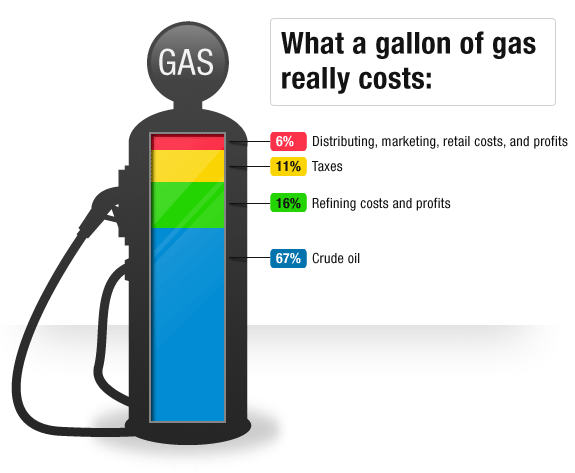The Real Reason for High Gas Prices
For much of this year, gas prices have been sky-high. Consumers and businesses alike have felt the pain. Trucking and distribution companies, as well as the airlines, are just some of the businesses hurt by higher fuel costs. For consumers, the impact is more obvious -- more money spent on fuel means less money to spend on other items.
Why has gas been so expensive this year? And while prices have recently started to fall, what does the future hold?
The gas price puzzle
The fact that gasoline prices have been so high this year is understandably baffling. Domestic production of gasoline's biggest component, crude oil, is surging while, at the same time, imports are falling.
Meanwhile, the demand for gas has been falling sharply over the past five years. Since 2007, Americans have been driving fewer and fewer miles because of tough economic times and the aging of baby boomers. They've also been trading their older gas-guzzlers for newer, more fuel-efficient vehicles, as well as switching over to alternative means of transportation.
So with domestic supply up and gasoline demand down, why have some consumers been shelling out more than four bucks for a gallon of gas?
Why gas prices have been so high
To answer that question, let's take a look at what consumers paid for in a gallon of gas in March.

As you can see, crude oil makes up the bulk of the price you pay at the pump. So to understand gas prices, we have to look at the factors driving the price of crude oil.
While speculation and the value of the dollar do play a role, crude oil prices in the long run are driven primarily by global demand and supply fundamentals.
A growing global economy demands more industrial resources, and oil, the so-called lifeblood of modern economies, is at the top of that list. For much of the past decade, stronger growth in emerging markets such as China and India has sent global demand skyrocketing. So while surging domestic production may have reduced our reliance on imports, our pump prices are still captive to the supply and demand fundamentals of a global marketplace.
Reductions in global supply, especially when unexpected, play an important role as well. In the first quarter of the year, non-OPEC supplies, which comprise 60% of the world total, fell by 750,000 barrels a day. Reduced output from non-OPEC countries raises the market's reliance on OPEC's spare capacity, which tends to raise prices.
And finally, there's Iran. As the world's fifth largest oil producer, just the threat of a supply disruption in the region caused prices to spike. Concerns regarding Iran's nuclear program resulted in what energy analysts call the "Iran premium" built into oil prices, which kept them significantly more elevated than they otherwise would have been.
But in the past month or so, favorable developments in the global oil market have gradually started to ease the pain at the pump.
Why gas prices have started to fall
Gasoline prices fell to a national average of $3.71 per gallon recently, down from an early April high of $3.94 per gallon. As we head into the Memorial Day weekend, consumers can expect further declines with some estimates projecting a national average of $3.60 a gallon. According to the Oil Price Information Service's chief oil analyst, several parts of the country could see prices as low as $3.25 during the long holiday weekend.
The main reason? Crude oil fell to a six-month low last week and is down 11% this quarter. After months of global supply issues, oil inventories are back on the rise, boosted by improved capacity in Saudi Arabia and increased production from Iraq and Libya. In addition, weaker economic growth in Europe and the U.S. has helped curb global demand. And finally, tensions regarding Iran's nuclear program appear to be easing, though they remain one of the biggest threats to another price hike.
According to a forecast by the Energy Information Administration, gas should average $3.79 per gallon during the summer driving season. While still slightly higher than last summer's average, it's a far cry from earlier predictions of four to five bucks a gallon.
Implications for oil companies
When the price of oil rises, it tends to benefit certain oil companies. Conversely, when the price of oil falls, these companies see lower returns. The more levered the company, the greater the reaction to the oil price movement.
For example, a giant like ExxonMobil (NYS: XOM) would not be nearly as heavily affected by a large movement in the price of oil as other companies like Murphy (NYS: MUR) , Hess (NYS: HES) , or Apache (NYS: APA) . Indeed, the data support this observation. Since crude oil peaked in mid-March, shares of Murphy, Hess, and Apache have all followed a downward trend.
While these firms tend to rise and fall with oil prices, one company has found ways to profit regardless of price fluctuations. It's an under-the-radar oil and gas equipment provider that's set to crush the market. You can read about it in The Motley Fool's special free report "The Only Energy Stock You'll Ever Need." Find out the name of this company before the market catches on. Click here to access your report -- it's totally free.
The article The Real Reason for High Gas Prices originally appeared on Fool.com.
Fool contributor Arjun Sreekumar does not own shares of any companies listed above. The Motley Fool has a disclosure policy. We Fools may not all hold the same opinions, but we all believe that considering a diverse range of insights makes us better investors. Try any of our Foolish newsletter services free for 30 days.
Copyright © 1995 - 2012 The Motley Fool, LLC. All rights reserved. The Motley Fool has a disclosure policy.

